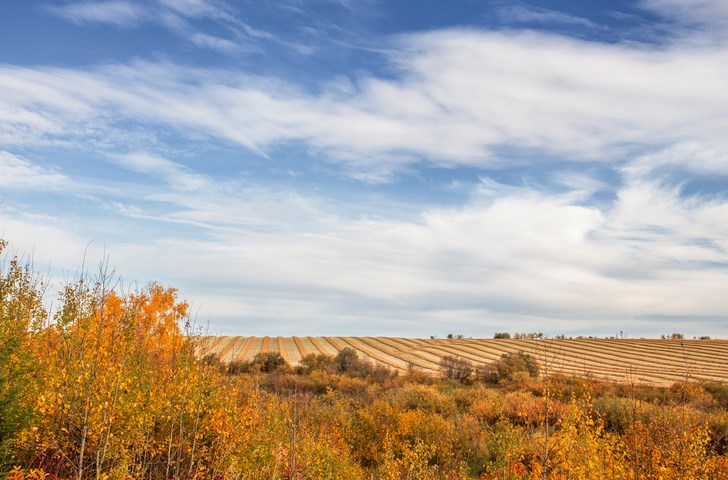SASKATCHEWAN — In any given year, localized conditions can result in crops 小蓝视频 unsuitable for harvest. It presents an opportunity to salvage them as livestock feed. However, there are a few points to consider before commencing salvage operations.
Can the crop be salvaged?
There are a few things that every producer should determine before launching salvage operations. If the crop was insured through Saskatchewan Crop Insurance Corporation (SCIC), they must be contacted prior to any salvage operations commencing. Call SCIC toll-free at 1-888-935-0000 to discuss all your options.
If the crop was sprayed with a product that has a feed or grazing restriction on the label, those must be adhered to prior to harvesting as livestock feed. Make every effort to determine what the crop was sprayed with and when. Then follow product label directions prior to using as feed. If the label is not readily available, consult the or contact the Agriculture Knowledge Centre at 1-866-457-2377 to speak to a livestock and feed extension specialist.
Finally, are the economics favourable? Baling costs range from $8 to $13 per bale, according to the or more depending on a variety of factors (fuel cost, tractor use, twine vs. net wrap, etc.). Typically, there are also additional transport fees to move the feed to where it can be used by the animals. Based on estimated nutritional value, is it worth baling and trucking the salvage crop, or does it make more sense to source other feedstuffs and supplements to compliment your winter-feeding program?
How will you salvage the crop and are the conditions favorable to salvage?
Mature crops that have lain and weathered in the field for several weeks will not make good quality chopped or bale silage. Aerobic bacteria will have established in the swath and will outcompete the anaerobic bacteria needed for proper ensiling.
As with all feed, moisture content of the feed needs to be considered. Bales containing 18-20 per cent moisture (or higher) have the potential to heat and lose their quality. During the heating process, some of the sugars (or feedable energy) will be used by microbes, resulting in a reduction in energy content available to the animals. If temperatures within the bale get above 40 C, a portion of the protein will be tied to fibre and therefore less available to the animals. The bales can smell sweet or like tobacco and the colour can change to dark brown or black. If this happens, it’s important to request an Acid Detergent Insoluble Nitrogen (ADIN) or ADIP (protein) test in addition to the regular feed analysis and use the adjusted lower protein value when formulating rations. Also consider the fire risk of heated bales – they should be monitored closely.
Moulds can also develop in higher moisture bales. Buffered propionic or formic acid can be applied to higher moisture feed to help prevent mold growth and heating. In some cases, these products could allow baling four to five per cent higher than normal. Moisture levels will likely remain high and the feed should be monitored and fed as quickly as possible. If mould growth does occur, bales can be rolled out to allow animals to sort through the feed. In these situations, feed waste will be higher, but it will limit the amount of moldy feed the livestock eat. In some cases, the feed may become so spoiled that it is not suitable for livestock, especially gestating animals.
How does the salvaged crop fit into your feeding program compared to other alternatives?
Feed tests are critical in these situations. In addition to gaining knowledge on the nutrient profile of the salvaged crop, you may also need to test for mycotoxins (fusarium, ergot alkaloids etc.), molds, sulphur or nitrates. Stressed (from drought or hail) or highly fertilized crops can contain high nitrate levels, which could lead to nitrate poisoning in livestock. In addition to nitrate concerns, brassica crops like canola can contain elevated amounts of sulphur, which can result in trace mineral deficiencies, polio and in the worst cases death.
In mature cereal crops, there is an approximate weight ratio of 1:1 grain to straw. Therefore, roughly one-half of the weight of each bale would be mature cereal grain. Depending on the type of cereal grain and the class of livestock 小蓝视频 fed, there is potential for grain overload and rumen acidosis. Care and planning when feeding this type of feed will be required.
Consider your overall winter-feeding program and total dietary intake (feed and water), in addition to palatability of the salvage crop. Will these salvaged crops be useful or a hindrance given cost (purchasing, baling, transport, etc.), storage and use (toxins, mold, nitrates, etc.) implications? In some cases, their use needs to be limited to avoid toxicity and other supplements may be a better fit.
For more information on utilizing salvaged crops as feed for your livestock, contact your by calling the Agriculture Knowledge Centre at 1-866-457-2377.
You can no longer count on social media to deliver important news to you. Keep your news a touch away by bookmarking SASKTODAY.ca's homepage at this link.
Here's why you should bookmark your favourites.
Subscribe to SASKTODAY.ca newsletter to get our daily news to your inbox.




